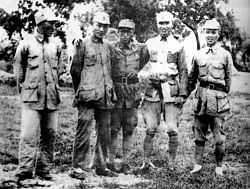Huang Kecheng
| Huang Kecheng | |
|---|---|
 General of the Army Huang Kecheng giving a speech | |
| Born |
1902 Yongxing County, Hunan |
| Died |
1986 Beijing |
| Allegiance |
|
| Service/branch |
|
| Years of service | 1926-1986 |
| Rank | General of People's Liberation Army |
| Battles/wars | Northern Expedition, Anti-Communist Encirclement Campaigns, Hundred Regiments Offensive, Campaign to Defend Siping, Siping Campaign, Liaoshen Campaign, Pingjin Campaign |
| Awards | Order of Independence, Order of Liberation, Order of the PLA |
| Other work | Politician, Writer |

Huang Kecheng (simplified Chinese: 黄克诚; traditional Chinese: 黃克誠; pinyin: Huáng Kèchéng) (October 1, 1902 – December 28, 1986) was a senior general in the People's Liberation Army.
Biography
General Huang Kecheng was born in Yongxing, Hunan, China, and he was the third of four children. His father was Huang Qingzhu (黄清主), and his mother was Deng Longtao (邓龙桃). His family owned six mu of land. Since he was not the eldest son, his parents did not consider it a great priority to provide a good education for him. He worked as a farm labourer on his family land, and completed high school when he turned 20, in 1920, from the Hunan 3rd Normal School. Huang eventually joined Chiang Kai-shek's New Revolutionary Army, and he joined the Communist Party of China in 1925.
In 1929, Huang was serving under Peng Dehuai in a Kuomintang regiment stationed in northern Hunan. When Peng rebelled in June 1928, Huang joined him.[1] Huang led the Yongxing campaign during Xiangnan (South Hunan) campaign in 1928, and participated major battles encountered by the Red Army Third Division. Huang participated in the Long March, and, upon arrival on northern Shaanxi, he was promoted to be the director of the general political and organizational department. In the beginning of the Second Sino-Japan War, he was the political commissar of 344 brigade, affiliated with the 115 division of Eighth Route Army. His army accompanied Xu Haidong, fighting in regions across Shanxi, Hebei and Henan. After 1940, he became a political commissar in the Eighth Route Army and the New Fourth Army, and later the deputy and logistics commander of Northeastern Democratic Alliance Army.
After the founding of the People's Republic of China in 1949, Huang was appointed governor of Tianjin. He later became the state secretary of Hunan, the Commander of Hunan Military Region and its political commissar, the deputy director of the chief staff and director of general logistics, the deputy minister of national defense, the secretary general of the Central Military Commission, and the chief of staff of the PLA. He was made a senior general in 1955, and awarded the Army Medal, the Independence and Freedom Medal, and the Order of Liberation. He was an alternate and then formal member of the 7th CPC Central Committee, and a member of the 8th Central Committee.
In 1959, Huang criticized the "Great Leap Forward" and "People's Communes" and was denounced as a member of an "Anti-Party group" associated with Peng Dehuai when Peng was criticized at the Lushan Conference. He was deprived of all positions and was placed under investigation. He was partially rehabilitated, but was denounced and persecuted by Red Guards when the Cultural Revolution began in 1966.
In 1977, after Deng Xiaoping came to power, Huang was politically rehabilitated. After being recalled to service, he was appointed as adviser to the Central Military Commission, and executive secretary of the Central Commission for Discipline Inspection. He was selected as central committee member again in 1978.
He died on December 28, 1986 in Beijing.
References
- ↑ Domes 48
Bibliography
- Domes, Jurgen. Peng Te-huai: The Man and the Image, London: C. Hurst & Company. 1985. ISBN 0-905838-99-8.
| Military offices | ||
|---|---|---|
| Preceded by Su Yu |
Head of PLA General Staff Headquarters 1958–1959 |
Succeeded by Luo Ruiqing |
| ||||||||
| ||||||||